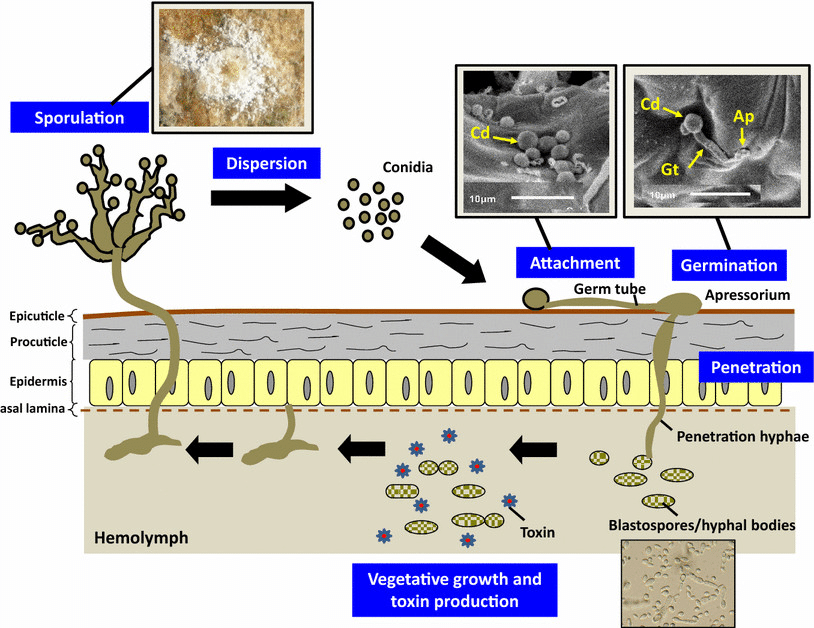A microscopic change is happening in the lush areas where dragon fruit is grown, where keeping pests away with MICROBIAL PATHOGENS and preserving the environment are very important. Welcome to the world of microbial diseases, which protect dragon fruit from pests without getting much attention. In this complex natural dance, these tiny fighters play an important role in upsetting the life cycles of pests, making sure that targets are hit accurately, and supporting sustainable farming.
Table of Contents

Microbial Pathogens for Dragon Fruit Pest Control
How to Understand the Microbe Orchestra: A Prelude to the Microsonic Symphony
Before talking about how microbial diseases can be used to get rid of dragon fruit pests, it’s important to know what problems this tasty crop is having. The dragon fruit plant, which is related to cacti, has to deal with many pests that hurt its health and output. Chemical pesticides are usually used, but this isn’t good for the earth, so we need long-lasting alternatives. This is where microbial maestros come in.
Upsetting the Life Cycles of Pests with Microbial Pathogens
The main job of the microbial orchestra is to mess up the life processes of pests. Broad-spectrum pesticides can hurt useful insects and the environment, but microbial pathogens only attack the things they are meant to. Bacteria like Bacillus thuringiensis and fungi like Beauveria bassiana take the lead and make proteins that kill certain bugs. This accuracy breaks the invaders’ life cycles, making sure that the pest control method lasts and doesn’t harm the environment.
Strategic Use of Microbes as Forces
Microbial forces make it possible for dragon fruit plants and their tiny guards to live together in peace. To use microbial pathogens, you need to have a deep knowledge of the dragon fruit ecosystem, taking into account things like temperature, humidity, and the orchard’s general health. This strategic method makes the microbial ballet work better while having less of an effect on organisms that aren’t the target.
Helping Microbes Do Their Job

Bodyguards of bacteria: Bacillus thuringiensis
Bacillus thuringiensis is one of the best actors in the microbial orchestra. This naturally occurring bacterium protects dragon fruit plants with its defences. Its arsenal includes cry proteins, which, when used on the crop, only attack the digestive systems of certain insect larvae. Cry proteins kill dragon fruit pests like caterpillars, ensuring that the defense system is precise and effective.

Fungi That Hurt You: Beauveria bassiana
When it comes to fungi, Beauveria bassiana stands out as a strong enemy for pests. When this entomopathogenic fungus is brought into the dragon fruit farm, it gets past the defenses of many pests, like beetles and aphids. Beauveria bassiana naturally eats these invaders, infecting them and reducing their numbers. The fungus shows how elegant solutions can be when they are based on nature. In this case, a fungus that was once harmful to dragon fruit fields is now helpful.
The Future of Microbial Pest Control: Taking Care of Dragon Fruit

Innovation in a Changing Environment
The use of microbial diseases to control pests is changing as dragon fruit farming moves into the future. The main goal of the ongoing study is to find new strains that are more specific and effective. Combining cutting-edge technologies, like genetic engineering and precision farming, will help make the use of microbes more effective in the ongoing fight against pests.
Promoting sustainability in farming
Using microbes to control pests in dragon fruit farms is most effective when it fits with environmentally friendly farming methods. As people around the world become more aware of how their actions affect the earth, the need for eco-friendly solutions grows. Microbial pathogens are great examples of sustainability because they use tactics that are both specific and based on nature. Using them not only protects dragon fruit crops but also helps build a strong and eco-friendly farming setting.
Conclusion: Microbes Are Amazing for Getting Rid of Dragon Fruit Pests
Microbiological pathogens play a delicate but powerful part in the symphony of dragon fruit farming. The careful disruption of pests’ life cycles, the accuracy of their bacterial and fungal allies, and the main idea of sustainability paint a clear picture of nature and farmland working together in harmony.
Pests are always changing how they attack dragon fruit farms, but these microbes are like sentinels, protecting the trees in a way that lasts. Even though new things are coming, the core of microbial pest control in dragon fruit farming will still be these tiny friends dancing together in a complex and strong way.
